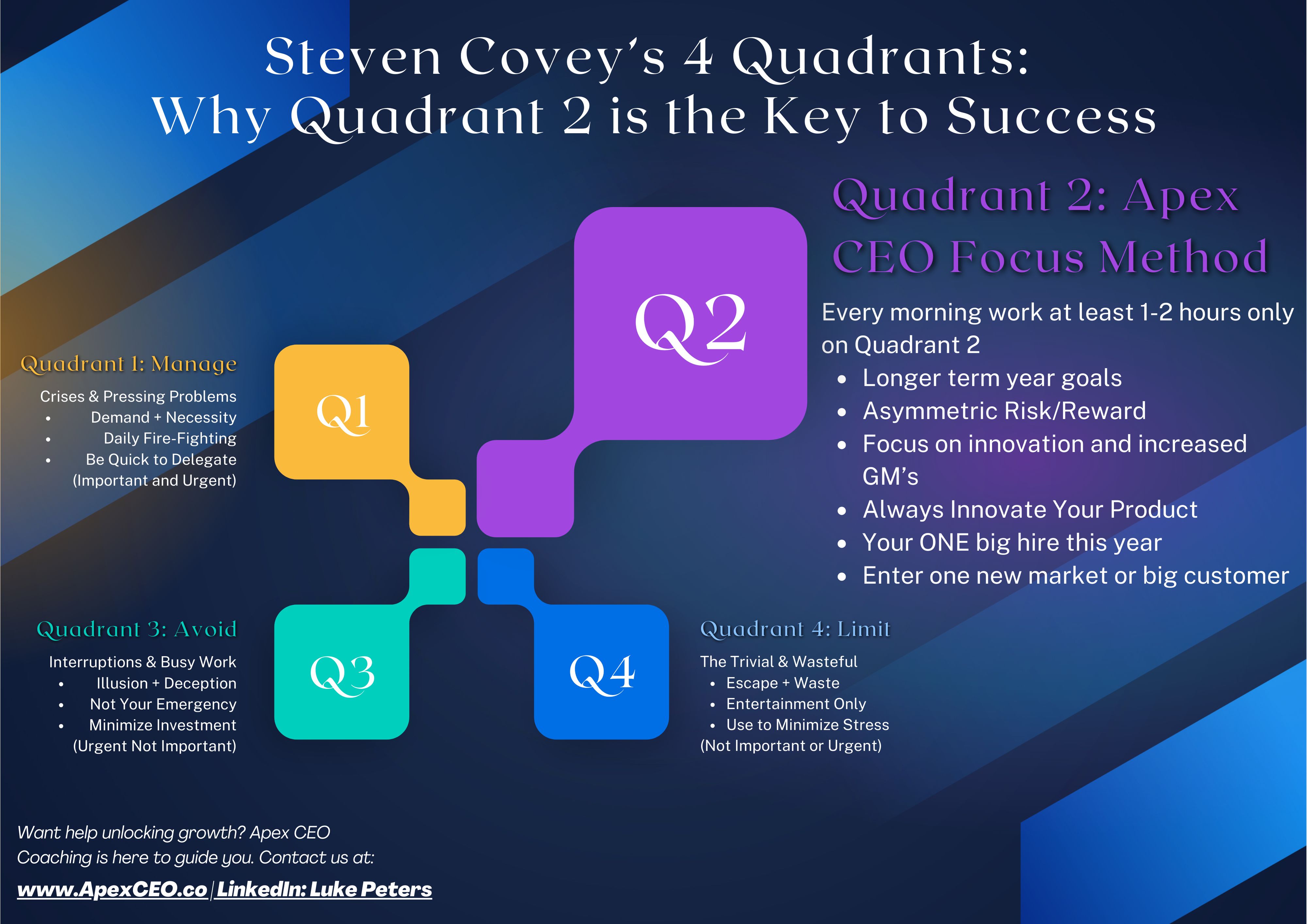When it comes to time management and productivity, few frameworks are as timeless and actionable as Stephen Covey’s Four Quadrants, introduced in The 7 Habits of Highly Effective People. Covey challenged leaders and entrepreneurs to shift focus from urgent tasks to what truly drives long-term value.
And if you’re trying to grow a business that lasts, there's one quadrant that matters more than the rest.
A Quick Breakdown of Covey’s Time Management Matrix
Covey’s system sorts tasks based on urgency and importance:
-
Quadrant 1: Urgent and Important
Crises, deadlines, fires. You can’t avoid these—but living here leads to burnout. -
Quadrant 2: Not Urgent but Important
This is the sweet spot. Strategy, planning, personal growth, and proactive leadership live here. It’s where long-term success is built. -
Quadrant 3: Urgent but Not Important
Distractions in disguise—meetings, interruptions, notifications. They feel urgent but don’t move the needle. -
Quadrant 4: Not Urgent and Not Important
Time-wasters. Endless scrolling, busy work, entertainment overload.
Most people bounce between Quadrants 1 and 3—reacting instead of leading. But real growth? That’s in Quadrant 2.
Why Quadrant 2 Changes Everything
Quadrant 2 is proactive. It’s the work that prepares you to win tomorrow—even if there’s no reward today.
Personally, I aim to spend two hours every day in Quadrant 2. Focused, intentional time on high-leverage work.
Why? Because Quadrant 2 delivers asymmetric returns—low downside, huge upside. Here’s what it looks like for business owners:
1. Innovate to Improve Margins
Don’t race to the bottom. Use innovation to create products your customers love—and are willing to pay more for. Better design, unique features, and standout experiences let you command higher gross margins.
2. Make One Game-Changing Hire Per Year
You don’t need to fill every role at once. Focus on one transformational hire annually. Maybe it's a head of sales, operations lead, or product visionary. One great person can change your entire trajectory.
3. Break Into One New Market
Growth often comes from expansion. Find one adjacent segment—new geography, new buyer persona, or new product line—and go after it. Don’t wait until your current market gets crowded.
4. Invest in Your Brand
A strong brand builds trust, commands premium pricing, and attracts loyal customers. Don’t treat brand as fluff. It’s your moat. Audit it regularly to make sure it matches your vision and values.
A Quick Story from My Journey
When I was building Newair, we faced pressure from low-cost competitors constantly undercutting us. They offered knockoff products at cut-rate prices, hoping to steal share.
Instead of panicking, we leaned into Quadrant 2.
We innovated smarter products. We doubled down on branding. We focused on providing standout service—not slashing prices.
As a result, our margins held strong—and our business became more attractive to investors. That discipline helped us land a private equity exit. None of that would’ve happened if we were just chasing short-term survival.
Making Quadrant 2 a Daily Habit
Here’s how to make Quadrant 2 part of your operating rhythm:
-
Block time on your calendar. Carve out at least two hours daily for strategic work.
-
Track your impact. Use OKRs, dashboards, or check-ins to measure outcomes.
-
Say no more often. Protect your time from urgent-but-not-important requests.
-
Review weekly. Reflect on what worked, what didn’t, and where to focus next.
Final Thoughts
Stephen Covey’s framework works—if you actually use it.
Quadrant 2 isn’t about doing more. It’s about doing the right things—before they become urgent. Innovation, hiring, expansion, and brand-building all start here.
If you’re serious about scaling a business that lasts, don’t wait for a crisis to shift your focus.
Start now.

